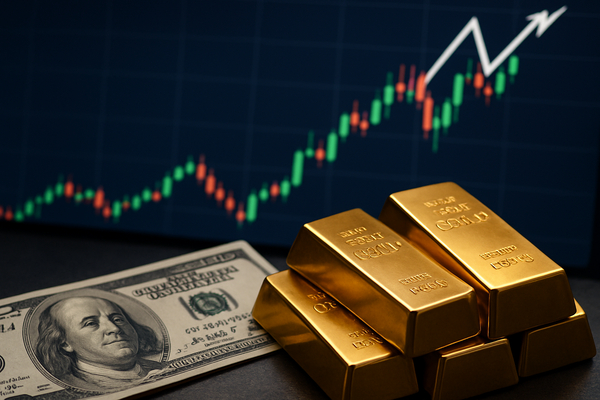
Opening snapshot: profit-taking and policy worries shape early moves
Global markets begin the session with a cautious air after a day of profit-taking erased some recent record highs. Major U.S. indices slipped, with losses ranging from about 0.2 percent on the Dow to roughly 1.1 percent on the Russell 2000. The pullback looks more like a pause than a capitulation, but it reflects a growing sensitivity to political gridlock in both the United States and France and mounting questions about central bank policy. The dollar climbed to a six week high and safe haven flows helped push bullion to a fresh milestone. Equity sector action was mixed, with consumer discretionary the weakest on the day and consumer staples offering shelter. Chip name strength stood out, with AMD advancing another 4 percent as investors continue to rotate within technology.
Foreign exchange and commodities: dollar strength and a blockbuster for gold
Currency markets are showing a classic risk repricing. The dollar rally has lifted USD/JPY to around 152.00 and pushed EUR/JPY to a new high near 177.00. Emerging market and smaller European currencies felt the pressure, with Hungary’s forint losing about 2 percent. Bitcoin pulled back about 3 percent after recent gains. Commodities produced the most dramatic headline. U.S. gold futures pierced the $4,000 an ounce level for the first time and spot prices closed within roughly $10 of that milestone. That represents a roughly 20 percent gain in six weeks and more than a 50 percent advance so far this year. Central bank buying and growing talk of debasement trades are cited as key drivers, and the path forward looks vulnerable to any changes in perceived policy direction.
Bonds and yields: long duration under pressure even as U.S. Treasuries find a breather
Sovereign debt markets remain under strain, especially at the long end. Japan set a new record for its 30 year yield at 3.345 percent. Across the Atlantic and in the United States yields came off marginally on Tuesday with Treasury yields down two to four basis points in a respite that may be short lived. A well received three year auction offered a moment of stability, but the broader trend is toward higher yields in many countries. The combination of monetary easing talk and fiscal loosening has market participants selling any rally rather than buying dips. That dynamic keeps risk premia elevated for long duration assets and leaves policymakers wrestling with how to maintain orderly market functioning while supporting growth and employment.
Liquidity and policy tension: reserves, Fed strategy and the “everything” rally
One of the clearest signals of financial plumbing tightening is the decline in U.S. bank reserves held at the Federal Reserve. Reserves have dropped below $3 trillion for the first time since January and are down nearly $300 billion since late August. While no specific level is sacrosanct, the decline approaches levels that some policymakers have previously flagged as hypothetically preferable. The interaction between shrinking reserves, potential Fed balance sheet operations and a policy bias that leans toward cuts to support a softening labor market raises difficult questions. The Fed’s stated objective of preventing a steep rise in unemployment has merit. At the same time, easier monetary conditions risk supercharging asset prices that are already at elevated valuations. Financial conditions are the loosest in over three years, credit spreads are the tightest since 1998, inflation sits about a percentage point above target, and GDP growth is running near an annualized 3 percent or higher. Under those circumstances a pre-emptive easing strategy can magnify the so called everything rally where equities, commodities and crypto all march higher in concert.
Market implications and what to watch for during the session
Traders will be sensitive to a string of macro releases and central bank commentary. Attention will fall on a New Zealand rate decision, Japan’s tankan and current account numbers, and Germany’s industrial production print for clues about the global growth pulse. Speeches by the Bank of England chief economist and the European Central Bank president could influence sentiment on policy divergence. In the United States a $39 billion auction of 10 year notes and publication of the Fed minutes from the September meeting will be scrutinized for any change in the committee’s thinking. Several Fed officials are scheduled to speak and their tone may determine whether risk assets regain momentum or give back more ground. A steady stream of headlines about fiscal politics, including warnings from the White House about potential shutdown consequences, could add to short term volatility.
Positioning and risk management: balancing momentum with caution
Given the current mix of stretched asset valuations and thinning liquidity, investors may prefer selective positioning rather than broad market exposure. Defensive sectors and cash rich names have shown resilience while cyclicals and small caps are more vulnerable to profit taking. Yield sensitive strategies need to factor in the real possibility of further upward pressure on long dated yields in jurisdictions where sovereign supply and policy settings generate strain. Commodities traders will keep a close watch on flows into gold which can be self reinforcing as momentum traders and central bank purchases interact.
Bottom line: a session dominated by policy signals and headline risk
Today’s session looks set to weigh every new policy signal and macro print more heavily than usual. The dollar’s recent strength, record levels in some bond markets, and gold’s ascent to $4,000 an ounce frame a backdrop where liquidity and valuation questions are front and center. Market participants should be prepared for headline driven moves and for a trading environment where the easiest path for prices may be to trade off the most recent policy hint or data surprise. Watching central bank commentary and the Treasury auction will be critical to gauge whether recent trends continue or pause for consolidation.












